

MindWing Concepts Blog tagged "Early" - MindWing Concepts, Inc. Our baby cousin Averycelebrating Dr.

Seuss! This week brings us to an exciting yearly event… Read Across America Day, March 2nd, created in honor of Dr. Seuss’ birthday. Dr. Two Tongues, One Brain: Imaging Bilingual Speech Production. Introduction Speech production is a complex motor act, involving rapid sequential motor movements that often extend over many seconds before a pause.
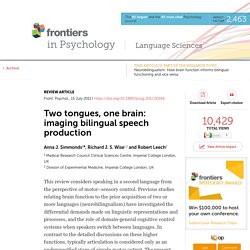
It depends on the integration of feedforward motor and feedback sensory signals, with online self-monitoring guiding rapid modification of motor commands to the larynx, pharynx, and articulators. This allows the maintenance of intelligible speech, even under adverse speaking conditions, for example, when speaking (less than politely) with one’s mouth full at mealtimes. It depends on motor (frontal), auditory (temporal), and somatosensory (parietal) cortex, as well as the insulae, cerebellum, and subcortical nuclei (Guenther et al., 2006; Ventura et al., 2009; Golfinopoulos et al., 2010).
A range of linguistic stages are involved in speech production. 1. Consonant Sounds. !

(Vision check: printable page with sentences in different size fonts. Read the sentences in the different sized fonts. Cover one eye and read sentences. Then cover other eye and read sentences. Write down what fonts you can see clearly and easily. . ~ Link to Starfall online website, ABC’s: Consonant sounds and letters The c0nsonants are all the letters that are NOT vowels. Vowels= a , e, i, o, u (and sometimes y ) Consonants= b c d f g h j k l m n p q r s t v w x y z. Vowel sounds in english language with examples k.
Synthetic Phonics Training - Home Page. Can phonics help us spell better? Children’s author and high-profile opponent of phonics instruction, Michael Rosen recently wrote this blog casting doubt on the idea that learning phonics could help people spell.

He was writing in response to an article written by Debbie Hepplewhite in Primary Matters. Here’s the extract with which he takes issue: The job of teaching and applying the English alphabetic code for spelling is NOT done by the end of the infants – it is just the beginning of a long-term need to be attentive, and to get to grips with, English spelling as an ongoing part of reading and writing.* Michael’s argument is that understanding the alphabetical code, or applying phonics knowledge as he interprets this, might help with spelling some words but is little help when trying to spell others. Debbie Hepplewhite Handwriting Home Page. Debbie Hepplewhite Handwriting Home Page.
Unit 1. Very helpful teacher-led ‘lesson introduction’ material for every new, or focus, letter/s-sound correspondence in Units 1 to 12: This resource was originally provided only in Units 1 to 6 of the Early Years Starter Package webpage (alongside a pupil-version with line drawings).
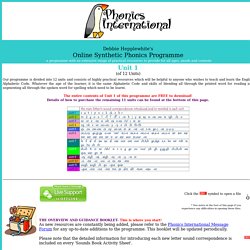
It has proved to be such a helpful and popular resource for adults to introduce the new or focus letter/s-sound correspondence that it has now been added to the full Phonics International programme and extended to Units 7 to 12. The CORE TEACHER MODELLING CARDS’ include the same key pictures and example words which are used on the Phonics International English Alphabetic Code Charts. The ‘teacher’ is advised to point to the focus sounds and graphemes on the preferred version of the Alphabetic Code Charts as part of the introduction to the lesson.
Alphabetic Code Charts - Home Page. Phonics International Pre-School Home Page. ♂~let's have fun with phonics~♀: The English Alphabetic Code. Alphabetic Code Charts - Home Page. Alpha-Phonics complete reading program! Two sixty minute audio CD Roms contain comprehensive verbal instruction designed to greatly aid using the book Alpha-Phonics.
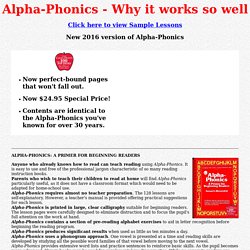
Thoroughly reproduces phonogram sounds, you will be teaching your student. Two cd set. Price: $24.95 + $5.00 P&H. Sam Blumenfeld's Original Alpha-Phonics Home Page. Literacy/ESL Archives. Core5: Scope & Sequence. Student-Driven Learning | Assessment Without Testing | Instruction & Practice | Scope & Sequence | Alignments & Correlations | Mobile | WEBINARS Lexia Reading Core5® provides all students—from at risk to on-level and advanced—a systematic and structured approach to six areas of reading, from phonological awareness to comprehension.

The program creates personalized learnings paths for each student through an adaptive placement and scaffolded activities that align to Common Core and other rigorous state standards. Phonics activities include the ability to apply knowledge of letter-sound correspondence to reading and spelling words. Literacy Instruction for Individuals with Autism, Cerebral Palsy, Down Syndrome, and Other Disabilities. What is sight word recognition?
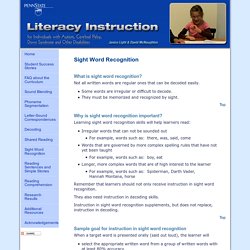
Not all written words are regular ones that can be decoded easily. Some words are irregular or difficult to decode. They must be memorized and recognized by sight. Top. English Language Arts Archives - Page 2 of 38 - WeAreTeachers. Online English practice. 7. Intonation, Strees and Rythm. Elements upon group of segments: Intonation It is the variation of pitch while speaking.
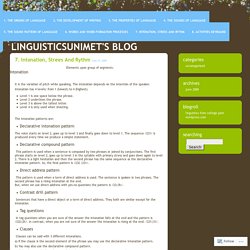
The intonation depends on the intention of the speaker. Intonation has 4 levels: from 1 (lowest) to 4 (highest). Level 1 is one space below the phrase.Level 2 underlines the phrase.Level 3 is above the tallest letter.Level 4 is only used when shouting. The intonation patterns are: Guided Kindergarten Reading Lessons. Lesson plans Archives - Pre-K Pages.